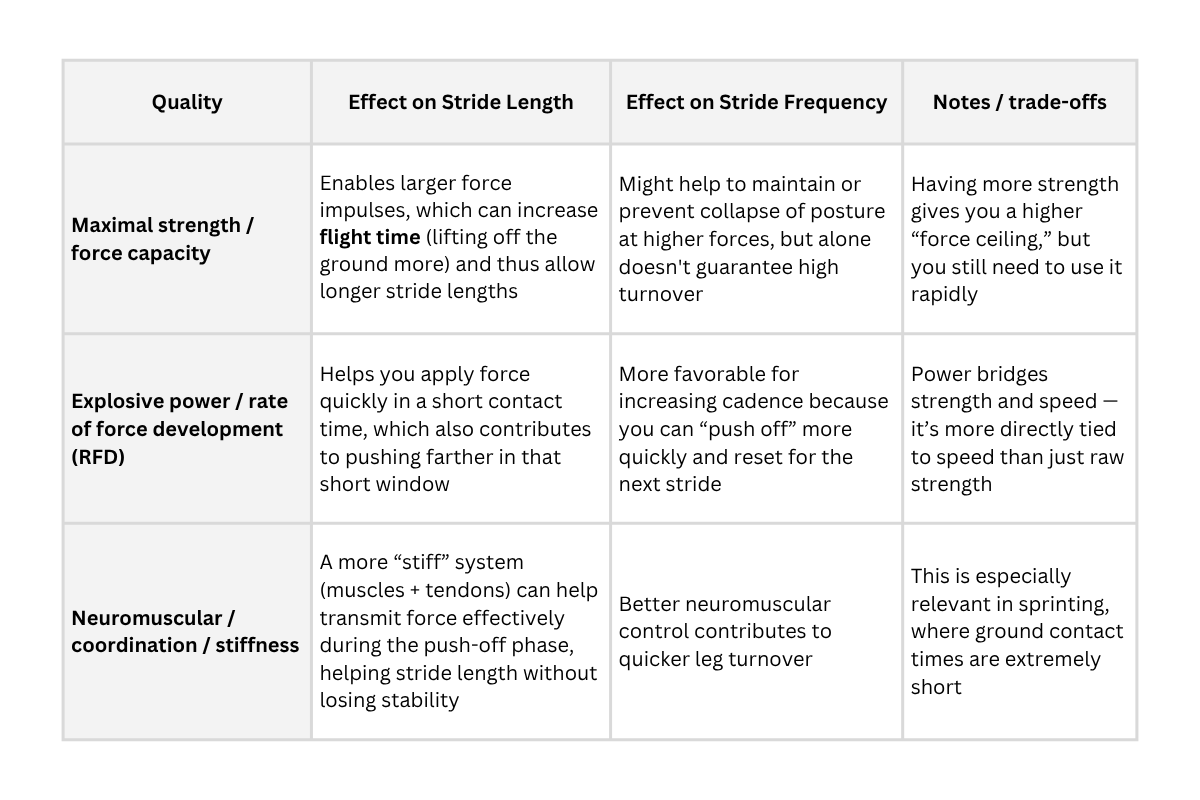Stride Length vs. Stride Frequency: Which Is King in Sprinting?
The 2025 World Athletics Championships in Tokyo showcased a thrilling men's 100m final, where Oblique Seville clinched gold with a personal best of 9.77 seconds, edging out fellow Jamaican Kishane Thompson (9.82s) and American Noah Lyles (9.89s). This race reignited the debate: Is it stride length or stride frequency that truly determines a sprinter's success?
Lets first look into the heights of the top 10 sprinters (ranked) of all time:
*With the average height of 1.81m
This spread shows a fascinating trend: world-class sprinters are not confined to one body type. From the towering Bolt at 1.95 m to Seville at just 1.70 m, athletes succeed in very different ways.
Stride Length: The Big Man’s Advantage
Stride length refers to the distance covered with each step. Taller sprinters like Usain Bolt and Fred Kerley naturally cover more ground per stride.
Bolt’s max stride length: ~2.7–2.9 meters
Kerley’s stride length: ~2.5–2.7 meters
This allows them to reach top speed in fewer steps. Bolt famously completed his 9.58 WR with just 41 steps, compared to the 44–47 steps most elites take.
But stride length isn’t everything. It requires incredible force production, mobility, and stability to sustain long, powerful strides without losing efficiency.
Stride Frequency: The Smaller Sprinter’s Weapon
Stride frequency (or cadence) is how many steps an athlete takes per second. Shorter sprinters like Oblique Seville, Christian Coleman, and Trayvon Bromell excel here.
Coleman’s cadence: ~4.6–4.8 steps per second at top speed
Seville’s cadence: ~4.5+ steps per second at top speed
Bromell’s cadence: ~4.8 steps per second at top speed
This rapid turnover allows smaller sprinters to hit top speed earlier in the race, making them especially dangerous over 60m and in the acceleration phase of the 100m.
*The chart gives a visual comparison of the stride length and frequency of elite sprinters at peak velocity
The Balance: Where Champions Are Made
In reality, the best sprinters balance stride length and frequency. Too much focus on one sacrifices the other:
A long stride without frequency = slower turnover, reduced velocity.
A high frequency without stride length = short steps, wasted energy.
The sweet spot lies in optimising both relative to body type:
Tall sprinters (Bolt, Kerley, Powell) must learn to strike quickly enough to avoid being sluggish.
Shorter sprinters (Coleman, Seville, Bromell) must maximize force production to extend their stride without losing cadence.
Case Study: Seville vs. Thompson in Tokyo 2025
Seville (1.70 m): Shortest in the field, won with lightning-fast turnover and efficient mechanics.
Thompson (1.85 m): Taller, longer stride, but couldn’t match Seville’s higher frequency late in the race.
The Tokyo final perfectly highlighted that there’s no single formula—success comes from blending both stride length and frequency into an efficient, powerful sprint pattern.
Length or Frequency?
So, which is king—stride length or stride frequency?
The truth is: neither on its own.
Sprinting is about maximising speed = stride length × stride frequency. Each athlete must find the balance best suited to their body type, strength, and mechanics.
That’s why we see both 1.70 m Oblique Seville and 1.95 m Usain Bolt running sub-9.80s. The path is different, but the results are similar—blazing speed.
How strength & power push stride length and frequency?
Here’s how each of these physical qualities tends to affect stride parameters:
In practice, an athlete who is very strong but “sluggish” in force application might produce long strides but low frequency (i.e. heavy, slower legs). Conversely, someone with excellent neuromuscular quickness might achieve high cadence but lack the force to push the stride length much. The challenge is to balance both.
We can help!
What we can help you with at ATHLETIC INC
Improve strength foundations — you need the strength capacity so that the legs can push hard. But strength training should be complemented by power / speed development so that force can be expressed quickly.
Train rate-of-force development (RFD) (e.g. explosive lifts, plyometrics, contrast methods) because in sprinting, contact times are so short that how quickly you can generate force matters a lot.
Measure contact times and flight times — monitoring how these change can show improvements in how “efficiently” the athlete is applying force.
At ATHLETIC INC, we merge proven methodologies with modern technology to deliver data-driven insights that drive results.
Whether you're aiming for elite performance or mastering your favourite sport, achieve your peak through our integrated approach to strength, recovery, and nutrition. Speak to our experts today.
MEET THE AUTHOR
MING WONG
Strength & Conditioning, & Performance Coach
SPECIALISATIONS
Athletics
Running & Sprinting
Sports Massage
High Performance Training
Strength & Conditioning





